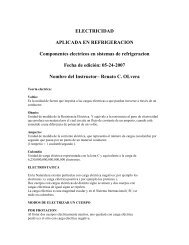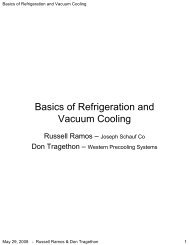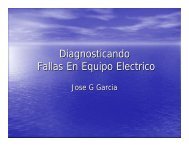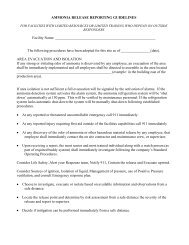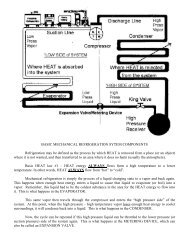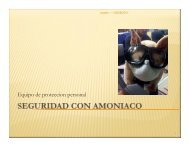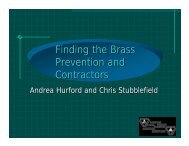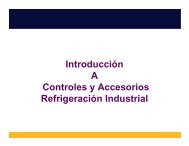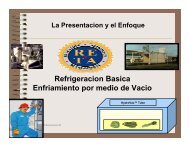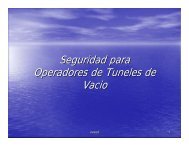Ammonia
Ammonia
Ammonia
You also want an ePaper? Increase the reach of your titles
YUMPU automatically turns print PDFs into web optimized ePapers that Google loves.
Agenda<br />
• Anhydrous <strong>Ammonia</strong> Handling<br />
• Chemical Properties of <strong>Ammonia</strong><br />
• Exposure Guidelines<br />
• First Aid Procedures<br />
• MSDS Review<br />
• Protective Equipment<br />
• Emergency Action Plan: evacuation, assembly &<br />
notification
Introduction<br />
• What is SAFE: Safe <strong>Ammonia</strong><br />
Facilities Education?<br />
– SAFE is a program designed to<br />
meet BASIC ammonia awareness<br />
training required annually by OSHA<br />
for individuals that may be affected<br />
by an ammonia release.<br />
– SAFE is not designed to be a<br />
comprehensive technical training for<br />
ammonia handling. Work with your<br />
Airgas sales representative to<br />
schedule an advanced technical<br />
training for your team working with<br />
ammonia.
<strong>Ammonia</strong> Handling<br />
• Site receives anhydrous ammonia via railcar
<strong>Ammonia</strong> Handling<br />
• <strong>Ammonia</strong> unloaded into pressurized bullet storage tanks
<strong>Ammonia</strong> Handling<br />
• Delivery trucks filled from storage tanks<br />
• In a truck or vessel, ammonia is in both liquid and vapor<br />
forms.
Safety Precautions<br />
• <strong>Ammonia</strong> Technicians are HAZWOPER trained<br />
• DOT emergency response guides are found in the cab of<br />
every Airgas ammonia delivery vehicle.<br />
• <strong>Ammonia</strong> delivery hoses are removed from service 3 years<br />
before manufacturers recommended expiration.
Safety Precautions<br />
• Delivery and storage equipment utilize best-in-class safety<br />
mechanisms:<br />
– Check Valves<br />
– Relief Valves<br />
– Remote shut down<br />
– Excess Flow Valves
What is <strong>Ammonia</strong>?<br />
• <strong>Ammonia</strong> is a combination of liquefied air and hydrogen,<br />
usually formed from natural gas decomposed by heating.
You Produce <strong>Ammonia</strong><br />
• <strong>Ammonia</strong> in small amounts is one of<br />
the basic life-giving building blocks for<br />
all mammals (including Man).<br />
• <strong>Ammonia</strong> is not a cumulative<br />
metabolic poison.<br />
• <strong>Ammonia</strong> is not a known carcinogen.
A Continuous Cycle<br />
• <strong>Ammonia</strong> in large<br />
quantities is used<br />
as fertilizer to make<br />
plants grow<br />
• Eating plants<br />
makes animals<br />
(including you<br />
and me) grow<br />
• Animal waste<br />
helps plants<br />
grow
Where is Anhydrous <strong>Ammonia</strong> Used?<br />
• Agricultural Applications<br />
• Chemical Process Industries<br />
• Pollution Control<br />
• Refrigeration<br />
• Water Treatment<br />
• Metal Treatment
Where is Anhydrous <strong>Ammonia</strong><br />
Located in Refrigeration Facilities?<br />
• Anhydrous <strong>Ammonia</strong> is found throughout the plant<br />
site including:<br />
– Pressurized receiver
Where is Anhydrous <strong>Ammonia</strong><br />
Located in Refrigeration Facilities?<br />
• Anhydrous <strong>Ammonia</strong> is found throughout the plant<br />
site including:<br />
– Pressurized receiver<br />
– Compressors
Where is Anhydrous <strong>Ammonia</strong><br />
Located in Refrigeration Facilities?<br />
• Anhydrous <strong>Ammonia</strong> is found throughout the plant<br />
site including:<br />
– Pressurized receiver<br />
– Compressors<br />
– Piping
Recognizing <strong>Ammonia</strong><br />
• The most recognizable<br />
property of ammonia is:<br />
Smell<br />
• <strong>Ammonia</strong>’s strong, pungent<br />
and irritating smell gives<br />
early and positive warning<br />
that ammonia is present.
Rule of Exposure<br />
• 5 ppm - You can smell it.<br />
• 50 ppm - It can harm you – Long Term Exposure<br />
• 300 ppm - IDLH – Immediate Danger to Life & Health<br />
• 5,000 ppm - It can kill you<br />
BASIC RULE:<br />
If you can smell ammonia – be concerned, move out of the ammonia<br />
cloud as soon as possible and immediately notify others.
Rule of Exposure – Values in PPM<br />
5 to 20<br />
Detectable<br />
5 50 500 5,000 50,000<br />
25<br />
PEL<br />
in<br />
Some<br />
States<br />
35<br />
STEL<br />
150 to 200<br />
General<br />
Discomfort<br />
Eye<br />
Tearing<br />
300<br />
IDLH<br />
50 ppm<br />
Detectable by all<br />
Fed OSHA PEL<br />
700<br />
Eye<br />
10,000<br />
Damage Skin<br />
Begins 1,700 Damage<br />
Coughing<br />
Bronchial<br />
Spasms<br />
SCBA required<br />
2,500<br />
May Be Fatal<br />
(30 Minutes or<br />
Less)<br />
Visible Cloud<br />
Immediately<br />
Fatal<br />
40,000<br />
Visible<br />
Cloud<br />
w/Moisture
<strong>Ammonia</strong> Exposure<br />
• Exposure to liquid anhydrous ammonia or high<br />
concentrations of ammonia vapor can cause:<br />
– Blindness<br />
– Dehydration of body tissue<br />
– Chemical burns<br />
– Frostbite<br />
• Learn the signs of a release, first aid procedures, and have<br />
an emergency action plan!
<strong>Ammonia</strong> Characteristics<br />
• Anhydrous = without water<br />
• Pungent, colorless gas<br />
• Stored as liquid under pressure<br />
(or refrigerated)<br />
• DOT: Non-flammable compressed gas<br />
• <strong>Ammonia</strong> UN identification number is 1005<br />
– This number identifies ammonia on shipping documents<br />
and vehicles as hazardous, and references information<br />
from DOT Emergency Response Guide.<br />
• Pressure varies greatly with temperature<br />
– 50˚ F = 75 psig<br />
– 90˚ F = 165 psig
<strong>Ammonia</strong> Characteristics<br />
• <strong>Ammonia</strong> is sensitive to pressure and<br />
temperature<br />
– A small volume of liquid anhydrous<br />
ammonia will produce a large volume of<br />
gas at atmospheric pressure.<br />
• <strong>Ammonia</strong> has a limited flammability range<br />
– 15-28% in air generally found only in<br />
confined space.<br />
– Mixtures of oil and ammonia may reduce<br />
lower level to 8%<br />
• <strong>Ammonia</strong> has a very strong affinity for<br />
water.<br />
– 1 gallon of water will absorb 1,300 gallons<br />
of ammonia vapor by volume.
<strong>Ammonia</strong> Loves Water<br />
This is BAD because :<br />
• NH3 attacks the moist areas<br />
of the body<br />
• The body is mostly water<br />
• The eye is 90% water<br />
• Exposure can result in<br />
immediate eye damage
<strong>Ammonia</strong> Loves Water<br />
This is GOOD because :<br />
• Water can be used for first-aid<br />
treatment for NH3 exposure<br />
• Water can be used to absorb<br />
an ammonia vapor release<br />
• NOTE:<br />
– Water should NEVER be used on<br />
liquid ammonia. This will result in<br />
a violent reaction and vapor<br />
release!
Water - First Aid for <strong>Ammonia</strong><br />
• Large quantities of water (15 minutes of continued flushing)<br />
are recommended for washing contaminated skin areas or<br />
for eye contact.<br />
• RULE: For an eye<br />
exposed to <strong>Ammonia</strong>,<br />
hold the eyelid open<br />
and wash for 15<br />
minutes with water
First Aid Treatment for <strong>Ammonia</strong><br />
INHALATION:<br />
1. Remove from exposure.<br />
2. Administer artificial<br />
respiration or oxygen if<br />
breathing has stopped.<br />
3. Seek medical aid.
First Aid Treatment for <strong>Ammonia</strong><br />
SKIN CONTACT:<br />
1.Immediately flush with<br />
large quantities of water<br />
and continue for 15<br />
minutes. Do not remove<br />
clothing if frozen to skin.<br />
2.Seek medical aid.
First Aid Treatment for <strong>Ammonia</strong><br />
EYE CONTACT:<br />
1. Immediately flush with large<br />
quantities of water. Continue for 15<br />
minutes.<br />
2. Seek medical aid.
First Aid Treatment for <strong>Ammonia</strong><br />
INGESTION:<br />
1. Do NOT induce vomiting. Give 1-2<br />
glasses of milk or water.<br />
2. Seek medical aid.
Anhydrous <strong>Ammonia</strong> MSDS Sheet<br />
1. Chemical Product & Company<br />
Identification<br />
2. Composition, Information on<br />
Ingredients<br />
3. Hazards Identification<br />
4. First Aid Measures<br />
5. Fire Fighting Measures<br />
6. Accidental Release Measures<br />
7. Handling and Storage<br />
8. Exposure Controls/Personal<br />
Protection<br />
9. Physical & Chemical Properties<br />
10. Stability & Reactivity<br />
11. Toxicological Information<br />
12. Ecological Information<br />
13. Disposal Considerations<br />
14. Transport Information<br />
15. Regulatory Information<br />
16. Other Information
Personal Protective Equipment (PPE)<br />
Requirements For <strong>Ammonia</strong>
Skin Damage<br />
• Critical skin damage begins at 24.8°F and becomes irreversible<br />
at -18.5°F.<br />
• The degree of tissue injury is proportional to the duration and<br />
concentration of exposure.<br />
• Alkaline burns go deeper than acid burns.<br />
• Alkali burns are yellow, soapy, and soft in texture. When burns<br />
are severe, skin turns black and leathery.
What NOT to wear<br />
• Never wear contact lenses when working near ammonia!<br />
– <strong>Ammonia</strong> may become trapped behind the contact lens, increasing<br />
the risk of damage to the eye and reducing the effectiveness of the<br />
eyewash.
Respirators & SCBAs<br />
• Several types of respirators available<br />
– Full-face, 1/2 mask, Escape<br />
– Cartridge or Canister<br />
• Only use respirators for escape or in a MINOR release:<br />
– <strong>Ammonia</strong> odor while using a respirator might indicate improper fit,<br />
missing or broken seals, or ammonia concentration exceeding<br />
capacity.<br />
• Self-Contained Breathing Apparatus (SCBA) required for<br />
major releases<br />
– Should only be used by Emergency Responders<br />
• Proper use of respiratory equipment requires training,<br />
maintenance and practice!
Additional Safety Concerns<br />
• Do not fill storage tanks more than 87.5% or a hydrostatic<br />
condition may result<br />
– When a vessel (tank, pipe segment, etc.) is completely filled with<br />
liquid ammonia it is in a hydrostatic condition<br />
– When in a hydrostatic condition, a small temperature increase can<br />
cause an extreme, rapid increase in pressure that may result in<br />
rupture
Additional Safety Concerns<br />
• Never leave equipment unattended during and ammonia<br />
delivery!<br />
• Ensure that Hydrostatic Relief Valves (HRVs) are installed<br />
wherever liquid can be closed between two points in piping
Additional Safety Concerns<br />
• Do not use ‘yellow’ metal components:<br />
– Copper or copper alloys, zinc, or brass
Additional Safety Concerns<br />
• Ensure that hoses and relief valves are not expired and are<br />
in good condition<br />
• Vessels that read 0 PSIG may still contain ammonia!<br />
– Liquid ammonia at -28ºF exists at 0 PSIG<br />
• Welding on pressure vessels is regulated and should only<br />
be done in authorized repair shops- NEVER on a vessel<br />
containing ammonia!
<strong>Ammonia</strong> Cylinder Concerns<br />
• Do NOT:<br />
– Open and close valves to check<br />
operation<br />
– This will release additional<br />
ammonia!<br />
• ALWAYS:<br />
– Loosen caps and plugs slowly<br />
to vent trapped ammonia before<br />
removing.<br />
– Be sure that valves behind caps<br />
and plugs are tightly closed!
Recognize How an <strong>Ammonia</strong> Vapor<br />
Release Might Look<br />
• <strong>Ammonia</strong> Vapor<br />
– Lighter than air<br />
– May be colorless as below<br />
– May have a visible cloud as below
Action for an<br />
<strong>Ammonia</strong> Release<br />
• If you smell<br />
ammonia, see it, or<br />
hear an alarm,<br />
immediately do the<br />
following:<br />
Follow your plan!<br />
Evacuate the<br />
affected area<br />
Notify everyone in<br />
the affected and<br />
surrounding areas<br />
Assemble to be counted
Get Out Of A Vapor Cloud<br />
Aerosol<br />
Stream<br />
Dense Gas<br />
Vapor<br />
• Which way do you move to get out of the way of an<br />
ammonia vapor cloud?<br />
UPWIND? DOWNWIND? CROSSWIND?
Using the Windsock<br />
• Windsocks can help you identify<br />
what way the wind is blowing.<br />
• In the event of an ammonia<br />
release you want to move<br />
upwind.
Assemble To Be Counted<br />
• Follow the site’s Emergency Action Plan<br />
• Know your designated Assembly Location<br />
• DO NOT LEAVE the Assembly Location<br />
until you have been accounted<br />
for and are instructed to leave
Site Emergency Action Plan<br />
• Required for every site which falls under the EPA’s Risk<br />
Management Plan requirement<br />
• Includes evacuation routes and assembly points<br />
• Should be part of site safety orientation
Evacuate<br />
REMEMBER<br />
If a release occurs,<br />
know where to go!<br />
Let the Emergency<br />
Responders handle<br />
the incident.
Notification: Be PROMPT!<br />
• 911<br />
• Certified Unified Program Agency Administering Agent<br />
(CUPA/AA)<br />
• Governor’s Office of Emergency Services<br />
Warning Center<br />
• National Response<br />
Center (NRC) : 15 min<br />
• Air Quality<br />
Management<br />
District
Notification<br />
• Local Emergency Planning Committee (LEPC)<br />
• CHEMTREC (For transportation related incidents)<br />
• County Health HAZMAT<br />
• Fire Department<br />
• County<br />
Sanitation<br />
District<br />
(If entering<br />
sewer)
<strong>Ammonia</strong>-Related Regulations<br />
& Standards<br />
• ANSI K61.1 - Safety Requirements for the<br />
Storage and Handling of Anhydrous <strong>Ammonia</strong><br />
• OSHA 29 CFR 1910.11 - Storage and handling<br />
of anhydrous ammonia<br />
• OSHA 29 CFR 1910.119 - Process Safety<br />
Management (PSM)<br />
• EPA 40 CFR Part 68 - Risk Management<br />
Plan (RMP)<br />
• California Title 8<br />
• www.gpoaccess.gov/cfr/index.html
<strong>Ammonia</strong>-Related Regulations &<br />
Standards in California<br />
• Federal, State, County AND City regulations may include:<br />
– California Title 8<br />
– CalOSHA<br />
– CUPA<br />
– LA County Fire<br />
(or local department)<br />
– SCAQMD<br />
– LA County (or local)<br />
Health Hazmat
RMP/PSM Requirements for<br />
Anhydrous <strong>Ammonia</strong><br />
• PSM Prevention Program<br />
• Documented Management System<br />
• Worst Case & Alternative Release Scenario<br />
Analysis & Modeling<br />
• Submittal of RMP Summary<br />
to EPA
PSM Prevention Program<br />
• Process Safety Info<br />
• Process Hazard Analysis<br />
• Operating Procedures<br />
• Training<br />
• Mechanical Integrity<br />
• Management of Change<br />
• Pre-startup Safety Review<br />
• Compliance Audits<br />
• Safe Work Practices<br />
• Employee Participation<br />
• Contractor Requirements<br />
• Incident Investigation<br />
• Emergency Response<br />
Procedures<br />
• Trade Secrets




